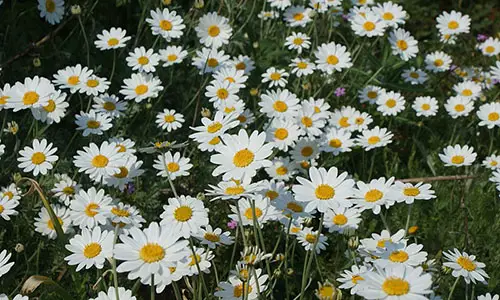Daisies, an herbaceous perennial, are low-growing flowering plants, coming back year after year from the roots, staying green and lively even in frost-free climates and the flower often blooms in colors like white, red, yellow and purple popularly. It is considered as the second largest family of flowering plants species. Remember the famous saying, “she loves me, she loves me not”? It was first carried out by using a daisy as well. Learn many more such exciting facts about Daisies below:
Family Information:
Kingdom: Plantae
Order: Asterales
Family: Asteraceae
Genus: Bellis
Species: B. perennis
Flower Description:
A daisy is a combination of two parts: a disk floret and a white ray floret, usually termed as two different flowers. The ray florets are at the border and the disk florets are at the middle. It is this arrangement that gives it an appearance of a single flower. This arrangement is a type of inflorescence known as a “capitulum”.
Quick Pointers about the Flower:
1. Daisies belong to “vascular plants”, one of the largest families of plants in the world and 10% of all flowering plants on the globe.
2. They belong to the Daisy family of Compositae (Asteraceae) in flowering plants and are native to north and central Europe.
3. The leaves of this flower are edible, meaning they can be used in salads and are high in Vitamin C content.
4. This type is the most popular flower and is found to grow everywhere on Earth except Antarctica.
5. The name “daisy” comes from two words of Old English: “daes eage”, meaning “day’s eye”, as it opens up with sunlight.
6. The type English Daisies is considered as a serious weed in the northwest United States. It is also considered to be a flower of children and innocence.
7. Daisies are found in all types of land, though flourish best in areas that stay fairly wet for some part of the year.
8. Its variant Gerbera Daisy ranks fifth most used cut flower in the world, after rose, carnation, chrysanthemum and tulip.
9. Bees are the chief pollinators of daisies. They are also commonly opposed to pesticides and insects.
10. Daisy is both used as a girl’s name or as a nickname for girls’ named Margaret, after the French name for the oxeye daisy, “marguerite”.
Varieties of Daisy:
Among all the varieties, Gerbera Daisy, Shasta Daisy and African Daisy are the most popular ones. Others are Spanish Daisy, Paris Daisy, English Daisy, Sunshine Daisy, Dahlberg Daisy, Butter Daisy, Painted Daisy, Blue Daisy, Prairie Daisy, Marguerite daisy, Gloriosa Daisy, Michaelmas Daisy, Giant Daisy, Swan River Daisy, Tatarian Daisy, Ox-eye Daisy, Nippon Oxeye Daisy, Zulu princess Daisy, Kingfisher Daisy, Gerbera Daisy, Barberton Daisy, Tahoka Daisy, Livingstone Daisy, Painted Daisy and Crown-Daisy.
Culinary or Medical Usage:
Daisies also have multiple herbal qualities besides just being used for decorations and for making daisy chains in children’s games. It can be primarily used as a potherb, by using it for salads etc and can also be boiled and consumed as tea for vitamins. It also has amazing astringent properties and can be used for cuts, wounds etc. It is still used in many villages after certain surgical procedures or to make certain homeopathy medicines. Its juice is also considered good for treatment of disorders of the gastrointestinal and respiratory tract.
Wild daisy tea is also good for coughs, bronchitis, disorders of the liver and kidneys, as well as for swelling (inflammation). It is also an excellent blood purifier.
Other Names:
Other names are Bellis perennis, Margarita Común, Pâquerette, Pâquerette Margueritte, Pâquerette Vivace, Bruisewort and Petite Marguerite. The most popular types are Marguerite daisy, Gloriosa daisy, Shasta daisies, African daisy and Gerber daisy.











Leave a Reply